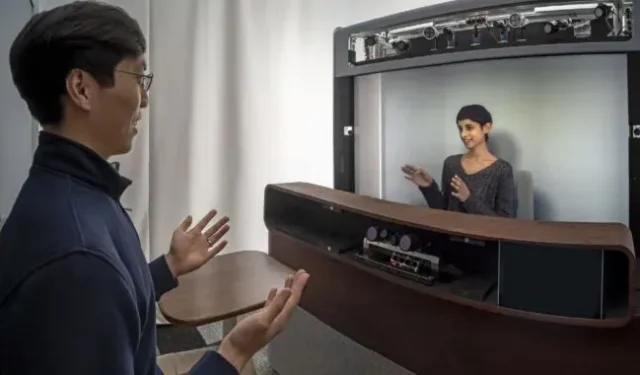Google is getting serious about its giant video chat booths and is starting real-world testing

It looks like Google is taking its wild video booth idea “Project Starline”seriously. The enigmatic project was announced as part of the Google I/O 2021 keynote, but was initially overshadowed by the more tangible announcements of Wear OS and Android. It’s been a year now and Google is still pushing the idea by announcing extended enterprise testing with third parties. Google says it’s also working to make Starline “more accessible.”
Project Starline basically asks the question, “What if Zoom was a giant arcade machine?”While the home console version of video chat includes a tiny camera above your laptop screen, Starline brings 3D video chat to life in a 7ft x 7ft seated cockpit, seemingly oblivious to cost, size, or commercialization. The goal is to give the impression that the other person is in the room with you, and Google classifies this as a “research project”.
As for what Starline actually is, the Google Research paper goes into enough detail. The display side of the video booth has 14 cameras and 16 IR projectors that work to create, capture and track a real-time, photorealistic 3D user avatar. Four microphones and two speakers don’t just play speech, spatial audio and dynamic beamforming supposedly make speech sound like it’s coming from the avatar’s mouth.
Sending a 3D avatar over a video chat connection allows Google to correct the eyeline, which is a constant problem with regular video chat. While the webcam at the top of the display makes it impossible to make eye contact when looking at the display, the 3D avatar can simulate a gap between the center of the camera and the center of the display, allowing mutual eye contact. Google processes all this data on a powerful workstation with two Xeon processors and “four NVIDIA GPUs (two Quadro RTX 6000 and two Titan RTX)”.
The display is a 65-inch 8K 60Hz autostereoscopic bi-convex panel that creates a life-size 3D avatar image without glasses. It’s basically a big Nintendo 3DS, but with a big advantage thanks to head tracking. The other side of the cockpit is equipped with infrared illumination and a rather rigid bench to limit the user to a 3D sweet spot on the display and limit the capabilities of the entire avatar generation system. Google even built a small barrier between the bench and the display to hide the bottom of the display. Instead of the avatar ending awkwardly once you hit the bottom of the screen, the physical occlusion at the bottom of the display supposedly tricks your brain into thinking the rest of the avatar is behind a barrier. Google seems to
People who have tried Starline seem to like it, but given that you have to be personally invited by Google to try it, that’s only a very small group of people. It’s hard to imagine a big market for what should be a six-figure video booth the size of a small bathroom, but Google is moving forward with more testing. Google said in a statement: “Today, Project Starline prototypes can be found at Google offices across the US, and employees use the technology every day to meet, onboard and build rapport with colleagues.”
The company continues, “In addition to Google employees, we also invited over 100 corporate partners in areas such as media, healthcare, and retail to participate in demonstrations at Google offices and provide us with feedback on experiences and applications for their businesses. We see many ways Project Starline can add value to businesses across a range of industries, and we remain focused on making it more accessible.” Salesforce, WeWork, T-Mobile and Hackensack Meridian Health signed up to try it out. WeWork, a company based on overpriced office space, seems particularly excited about the idea.
Google can talk about “research”all they want, but the company is very aggressive when it comes to destroying things that don’t have hundreds of millions of users. Will there ever be a product here? Starline kind of joins the huge market for corporate meeting equipment, but some limitations make Starline difficult for serious meetings. Corporate meeting equipment is typically designed for a large group of people sitting around a table, and broad compatibility means anyone can call into a meeting with just about any equipment. Starline only works with one person for private chats and you can only chat with other Starline cabs. Is there a demand for communication booths between VIPs, like the modern version of the president’s red phone?
Leave a Reply